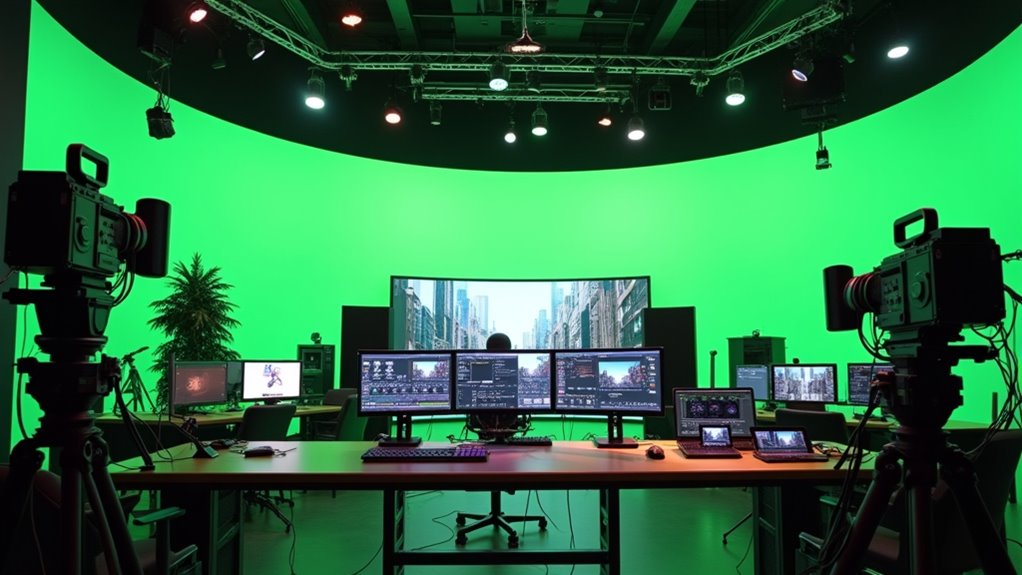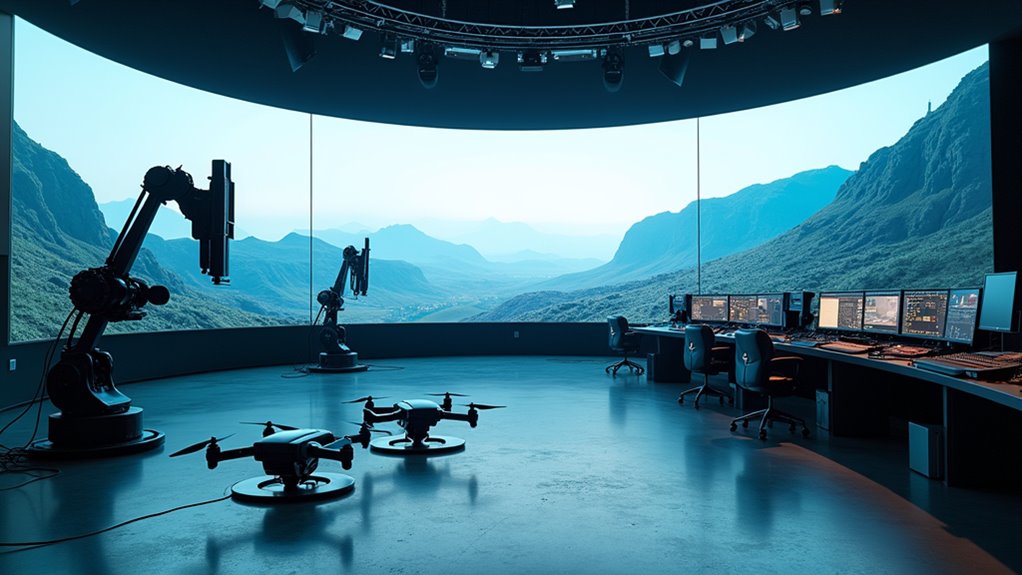The film industry today operates in a tech-driven ecosystem where streaming giants like Netflix and Amazon Prime dominate distribution, while digital tools revolutionize production methods. Traditional theaters compete with direct-to-streaming releases as global market forces, particularly China’s emergence, reshape viewing habits. Independent filmmakers leverage virtual production, AI-powered analytics, and cloud-based collaboration to create high-quality content on modest budgets. Understanding these dynamics reveals how modern cinema continues evolving at breakneck speed.
The Evolution of Movie Production in a Digital Age

While traditional film cameras once dominated Hollywood, the digital revolution has fundamentally transformed how movies are made, distributed, and experienced. The shift began dramatically with “Star Wars Episode II: Attack of the Clones” in 2002, when George Lucas boldly embraced digital cinematography, paving the way for countless others to follow suit.
Today’s filmmakers leverage sophisticated digital cameras and post-production tools that have democratized the entire creative process. Independent directors can now shoot feature films on modest budgets, as demonstrated by Danny Boyle’s “28 Days Later,” which proved that compelling storytelling doesn’t require expensive film stock. Technologies have evolved significantly from the days when editors relied on manual film splicing, making the editing process more efficient and accessible. This evolution has enabled streaming platforms to showcase indie films alongside major studio releases, revolutionizing distribution channels.
The integration of advanced editing software, coupled with powerful visual effects capabilities, has expanded creative possibilities while simultaneously reducing production costs. Virtual production technology has enabled filmmakers to create expansive digital environments at a fraction of traditional costs. This technological evolution has sparked a renaissance in filmmaking, where emerging directors can experiment with innovative techniques and storytelling approaches that were once reserved for big-budget studios, fundamentally reshaping the industry’s landscape.
Global Market Forces Reshaping Film Distribution
The global film distribution landscape has undergone a seismic transformation, moving far beyond the realm of traditional movie theaters and into the digital frontier. Streaming giants like Netflix, Amazon Prime, and Disney+ now dominate the market, fundamentally altering how audiences consume content while challenging conventional distribution models. These platforms enhance the intercultural connectivity that film provides, bridging audiences across borders.
This shift coincides with significant market expansion, as evidenced by the projected growth of USD 90.4 billion through 2029, with a robust CAGR of 14.6%. China’s emergence as a powerhouse market has sparked increased cross-border collaborations, while emerging economies drive investments in digital screens. January 2025 data shows streaming platforms maintaining dominance despite a global 10% decline in production volumes. While streaming services prioritize convenience, Blu-ray continues to offer superior quality for discerning viewers seeking the best possible home entertainment experience.
Meanwhile, traditional theaters find themselves competing with IPTV and digital platforms for viewer attention, forcing adaptation through enhanced experiences like 3D and VR technology. The rise of OTT platforms has created a new paradigm where direct-to-streaming releases coexist with theatrical premieres, reflecting the industry’s evolution toward hybrid distribution strategies that cater to changing consumer preferences.
Technology’s Impact on Modern Filmmaking

Modern filmmaking has undergone a revolutionary transformation through technological advances that permeate every aspect of production, from initial concept to final delivery.
From AI-powered script analysis to virtual production using massive LED screens, the traditional filmmaking pipeline has evolved into a high-tech powerhouse of innovation. Directors can now scout locations virtually, visualize scenes through digital storyboards, and capture stunning aerial footage with drones instead of costly helicopter shots. The implementation of 48 fps filming has revolutionized how action sequences are captured, delivering unprecedented clarity and smoothness in fast-paced scenes. Studios must now create mobile-friendly versions of their content to meet modern viewing habits.
Modern filmmaking fuses AI, virtual tools, and drone technology to transform traditional production methods into an accessible digital frontier.
The post-production landscape has similarly transformed, with cloud-based collaboration enabling global teams to work seamlessly on projects. Visual effects technology has revolutionized storytelling by allowing filmmakers to create previously impossible scenes and fantastical worlds.
Advanced tools like light field cameras and volumetric capture provide unprecedented creative control, while immersive technologies such as Dolby Atmos and VR experiences are pushing the boundaries of storytelling.
These developments haven’t just improved efficiency – they’ve democratized filmmaking, allowing independent creators to produce Hollywood-quality content on modest budgets, forever changing who gets to tell stories on screen.
Frequently Asked Questions
How Do Independent Filmmakers Secure Funding for Their Projects in Today’s Market?
Independent filmmakers leverage multiple funding streams in today’s market, combining traditional sources like film grants and private equity with modern approaches like crowdfunding and digital platform partnerships.
They often tap into regional tax incentives, pursue fiscal sponsorships through non-profits, and explore pre-sales opportunities at major film markets.
Strategic market intelligence and detailed project materials help secure these diverse funding sources, while streaming services create additional financing pathways.
What Qualifications and Skills Are Most Valuable for Aspiring Film Industry Professionals?
Today’s film industry professionals need a blend of traditional education and practical experience, with technical proficiency in industry-standard software being non-negotiable.
While formal film school credentials carry weight, hands-on experience through entry-level positions, like production assistants or post-production runners, often proves more valuable.
Strong communication skills, creative problem-solving abilities, and networking prowess remain essential, alongside the capacity to adapt to rapidly evolving technology.
How Do Film Tax Incentives Vary Between Different Countries and States?
Film tax incentives vary dramatically between regions, with some offering generous packages to lure Hollywood’s biggest productions.
While California keeps it modest with 20-30% credits, Louisiana goes big with up to 40% for in-state spending.
Internationally, the UK leads with credits up to 40%, while Spain sweetens the deal with regional bonuses like the Canary Islands’ 50% rebate, making location choices a key financial consideration.
What Percentage of Film Industry Workers Maintain Stable, Year-Round Employment?
Only a small minority, estimated at 15-20%, of film industry workers maintain stable year-round employment, typically in executive positions or permanent studio roles.
The vast majority work on a project-by-project basis, often cobbling together multiple gigs throughout the year.
Even established professionals like cinematographers and production designers frequently experience gaps between projects, while below-the-line crew members face even greater employment uncertainty and seasonal fluctuations.
How Does Union Membership Affect Career Opportunities in the Film Industry?
Union membership significantly enhances career opportunities in the film industry, providing access to higher-paying jobs, better working conditions, and essential benefits like health insurance and pension plans.
Major unions like SAG-AFTRA and IATSE open doors to prestigious productions, while offering crucial networking opportunities and collective bargaining power.
Though initial membership fees can be steep, the long-term career advantages make union affiliation a virtual necessity for serious industry professionals.
